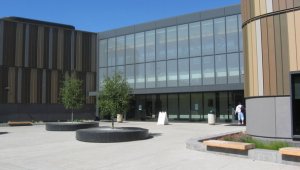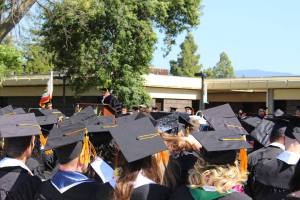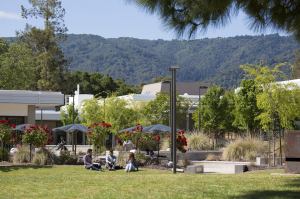Introduction
I have been teaching composition since the fall of 1985 when I was completing a Master’s degree in 19th Century British Literature at a college in the Bronx, New York. After that, I taught for seven years at a research university in the Midwest while I completed a doctorate in English with concentrations in Composition, Literacy and Culture. Then, for nine years, I taught undergraduate and graduate courses at a university in the Mid-Atlantic. During the last eleven years I have been teaching in a community college in Silicon Valley, California. During that long career, I have taught thousands of students from all walks of life, many of them Latin@s. On the East Coast, my Latin@ students were predominantly Puerto Rican (from the island and the New York tri-state area), Cuban and Dominican. In the Midwest, they were mostly “international” students from various places in Latin America, that cultural region that is a grouping of countries, south of the US, including the Caribbean, where Latin-based/Romance languages (Spanish, Portuguese, Italian and French) are spoken. In the Mid-Atlantic, my students were mixed: some were from the Spanish-speaking Caribbean, many from Central America (predominantly Honduras and El Salvador). And in Silicon Valley, my Latin@ students are overwhelmingly from Mexico and increasingly from Central America (Nicaragua, Honduras, Panama, Guatemala, Costa Rica, El Salvador and Belize).
I have to admit that throughout my teaching career being Latin@ has always driven me to pay just a tiny bit more attention to my Latin@ students no matter their backgrounds. Often, especially when I taught in the Midwest, I had no choice but to pay closer attention, because I was usually the “only” faculty member Latin@ students could identify as their ethnic and language own. Teaching in each of those distinct geographical regions of the US has presented unique challenges and great opportunities for me to learn. I have observed the needs of students, especially Latin@s and particularly in required general education composition courses, in each institution and its surrounding community. Each setting revealed much to me about what it means and what it takes to teach Latin@s–specifically, to teach composition.
I also have to admit that of all those teaching experiences the most challenging has been in the community college, because teaching load and students’ needs are overwhelming. During the last eleven years at the community college, I have taught 132 students per semester; that’s four sections of composition at once. And some semesters, since the load differs when I teach literature or Women’s Studies, the total has been about 175 students per semester. Moreover, the challenge is compounded because despite the college’s use of assessment tests that purportedly place students in appropriate classes, students’ skill levels and personal needs run the gamut. Many students are extremely well-prepared, sail through my composition courses, and then transfer to elite universities. But for the most part, my community college students are dramatically under-prepared, some having dropped out or never attended high school, some having just immigrated and are still dealing with economic, language and acculturation impediments.
The community college where I teach has about twelve thousand students and is situated in a beautiful park-like campus in an exclusive residential area of Silicon Valley. Forty-eight percent of the students are Caucasian; eighteen percent are Latin@/Hispanic (connected mostly to Mexico and Central America); thirteen percent are Asian; and slightly more than three percent are African American. Over twenty-six percent of the students range in age between twenty and twenty-four; twenty-one percent are over age fifty. Fifty-four percent of the students declare that their main intent is to transfer to a university; overwhelmingly, they transfer to California State University campuses. (Currently, one of the college’s Student Equity Plan goals is to address the low enrollment and success of Latin@s, African Americans, Asian and foster youth: “Decrease the achievement gap by meeting the success and retention benchmarks defined in the 2014 Student Equity Plan”; partly, that entails becoming a Hispanic Service Institution by the 2017-2018 academic year when the college intends to have increased the number of Latin@ students to 27%. That goal aligns with the college’s institutional level outcome: “Global Awareness and Diversity.”)

Early in spring, the city’s heritage orchard, right across the campus, blooms splendidly. (Photo by DMG)
Almost fifty percent of incoming students assess into non-transferable pre-collegiate composition courses—courses that used to be called “basic skills” and are now generally known as “developmental”; and those who test into freshman writing are significantly underprepared. That mix is muddled further by the fact that many of the students in both the developmental and freshman composition classes are not economically prosperous. They are the sons and daughters of, and those who work at, McDonald’s and Taco Bell, those who cut the grass, clean houses, babysit, and do construction. Some are challenged by learning disabilities, mental illness, substance abuse and gang-related issues. Some are undocumented, recently out of prison, on probation and/or court mandated to complete some kind of training program; most have at least two jobs. Their lives are busy, cluttered, and demanding.
Most of my students are mobile and wired. They change residences often, attend more than one college at once, and even those who can’t afford to buy their own laptops own a smart phone (and are reluctant to sit in the college’s computer labs). They expect to access information—and education—easily, on demand, from their fingertips anytime anywhere. They text compulsively and are active users of social media. Like most students today, they crowd source, meet new people and maintain friendships and family bonds, often across geographies, cultures, and time zones through Skype, Facebook, Twitter, Instagram, YouTube, and Tumblr.
Few take notes with paper and pencil; instead, they jot truncated words on their phones and tablets, or they use their hand-held devices to take pictures and videos of the information they want or need. (Those who can’t afford to buy a textbook use their smart phones to photograph it rather than go to the college library where I place copies on reserve.) Since it’s been in use for many years, most of my students (not all!) are at least familiar with using the college’s course management system (CMS) and its tools (discussion forums, drop boxes, chat sessions, calendar, email, podcasts). Many take classes online, including my composition courses (except developmental writing courses, since a few years ago, the English Department decided not to offer our pre-collegiate classes online believing that those kinds of students are doubly burdened by the requirements of the online mode of delivery.)
The entire campus is wired, so that students have free access to the internet even while relaxing out in a grassy common area. Almost all classrooms are equipped with current technology; the library has many desktop computers for students; and the Writing Center offers workshops and a computer lab. The college has a Puente Project, which provides academic and personal mentoring and support to Latin@ students enrolled in the program; pre-collegiate and first-year composition courses are at the center of that support.
Despite that infrastructure, Latin@s at the college have a very low 45% rate of success in composition classes (the general rate is 63%). And when those writing classes are taught online, the success rate is even more abysmal. It’s true that Latin@s’ rate of success is low across the disciplines and generally across institutions. (See my blog entry on review of the literature.) But that makes the situation even more urgent! Additionally:
- The most recent Fact Book at the college where I teach notes that for Latin@ students, the success rate of course completion is 58.7%, whereas generally in the CA community college system it is a much higher 63.2%.
- Latin@s are the youngest and fastest-growing population in the US.
- California has the largest Latin@ population in the entire United States, over 14 million.
- Since July 2013 the Latin@ population in California equals the non-Latin@ population.
- California is indeed becoming a minority-majority state.
- And yet, the Latin@ student population at the college where I teach hovers at only 18%.
- Given this population trend, inevitably, the college where I teach will be serving a steadily increasing number of Latin@ students.
- Yet the English Department at the college where I teach has 17 full-time faculty members; only two are Latin@s, and only three have any formal training in teaching Latin@s.
- Plus, a search for scholarship on teaching developmental and first year composition to Latin@s in the community college yields very little, and practically nothing when the search is narrowed to teaching them composition online.
Rationale
The reasons listed above drive me to spend a year researching and learning about what Latin@s need in the college composition class. I aim to find out by considering Latin@ culture specific pedagogy for teaching (both face-to-face and online) developmental and first year composition in the community college. Latin@s are not a monolith! Thus, my specific aim is to identify the practices that might be implemented in order to increase the rate of success for the kinds of Latin@s attending community colleges in California. I’m approaching this project from the stance that deliberately enacting Latin@ culturally informed and responsive pedagogy can help to improve the low success rate of Latin@s in developmental and first year composition classes.
I base that assumption on the improvement that has been documented across disciplines in the case of African American students who (as pedagogical theorists Dr. Gloria Ladson-Billings and Dr. Geneva Gay have been arguing since the mid 1990s) thrive with a culturally relevant pedagogy that “empowers” them. Indeed, Geneva Gay’s landmark book titled Cuturally Responsive Teaching: Theory, Research, and Practice affirmed that culture affects and “determines” how we think, behave and thereby learn, and how, consequently, teachers across the disciplines can be more effective when they imbue their pedagogy with students’ cultural needs. This pedagogical stance has grown very slowly when it comes to understanding the specific needs of Latin@s in community college writing classes. The virtually non-existent scholarship is one clear indication that more needs to be learned and tested.
I base that assumption also on the success of California Hispanic-serving institutions in increasing Latin@s’ persistence and graduation rates. Therefore, I’m starting my research project by looking at the practices implemented by professors teaching high numbers of Latin@s in Hispanic-serving community colleges in California. There are 81 “Hispanic serving” institutions in California–22 of them are community colleges. Part of what allows these institutions to appropriate the label “Hispanic-serving” entails recognizing and addressing the needs of Latin@ students; that is one major reason that the Hispanic Association of Colleges and Universities (HACU), and the US federal government, have deemed those colleges to be “Hispanic-serving.” I reason that English Department faculty teaching in those 22 Hispanic-serving community colleges have a treasure trove of information about how to effectively teach developmental and first year composition to Latin@s. During this research project, I aim to talk with many of those faculty members and to identify the best pedagogical practices for teaching college composition to Latin@s.
Side Note
The Hispanic Association of Colleges and Universities (HACU) is a national organization, founded in 1986 by de facto leaders of Hispanic serving colleges and universities, that has championed Latin@ success in higher education since its inception. HACU represents more than 400 colleges and universities committed to improving the success of Hispanic students in higher education in the United States, Puerto Rico, Latin America, and Spain. Because of HACU’s advocacy, in 1992 the US Congress began to formally recognize campuses with high Hispanic enrollment as federally designated “Hispanic Serving Institutions” (HSIs), and under Title V of the Higher Education Act, to appropriate grant money to those institutions. (In 2013, $95 million were appropriated.) Since the 2008 amendment of the Higher Education Act, the “Hispanic Serving Institution” status has been designated to any accredited and degree-granting public or private nonprofit institution with an undergraduate Hispanic full-time equivalent student enrollment of 25% or higher coupled with substantial enrollment of low-income students. Based on these criteria, there are over 300 HSI institutions in the United States, just over 6 percent of all degree-granting institutions that enroll over four million undergraduates, including one quarter of all minority undergraduates, and nearly one half of all minority undergraduates, in the United States. Seventy percent of these institutions are predominantly public, and 49 percent are two-year institutions. There are also 10 research universities and more than 50 master’s degree institutions.
I have divided this research project into three major tasks:
1. During the first part of the academic year (8 weeks), I will
- Attend HACU’s 28th Annual Conference, “Championing Hispanic Higher Education Success: Investing in America’s Future,” on 4-6 October 2014 in Denver, Colorado (see my entry describing the sessions I attended).
- Attend XITO’s “In Lak’ Ech: Engaging Chican@/Latin@ Studies with Culturally Responsive Pedagogy” institute especially arranged for faculty who teach in the Puente Program, on 13-14 November 2014 at Napa Community College in Napa, California (see my entry describing the sessions I attended).
- Engage in rigorous reading and understanding of pertinent scholarship on culturally responsive pedagogy (see my entry with the annotated bibliography).
- Compose a comprehensive annotated bibliography of foundational scholarship and other scholarship relating specifically to Latin@s.
- Plan the itinerary for visiting the 15 colleges.
- Arrange meetings, observations, and interviews with the 30 colleagues in those 15 colleges.
- Prepare for audio-taping (and some video-taping) interviews and other pertinent data.
2. During the second part of the academic year (8 weeks), I will
- Maintain a blog where I chronicle my work.
- Visit 15 Hispanic-serving community colleges that are somewhat similar to the college where I teach (in the total number of students enrolled) and yet enroll a substantially higher percentage of Latin@s, including
- ten community colleges in California (and for comparative purposes)
- two community colleges in New York City,
- two community colleges in Texas,
- and, tentatively, one private four year institution in Silicon Valley that was established specifically for Hispanics/Latin@s.
- During those visits I will
- familiarize myself with the campuses and the communities they serve,
- observe two instructors teaching developmental and freshman writing in each campus,
- interview (and audio-record) the two instructors of writing (I observe) in each campus. (For a list of the generative key interview questions, see below.)
3. During the last part of the academic year (8 weeks), I will
- Review my blog.
- Analyze and synthesize the scholarly review of literature
- with the data gathered while observing the teaching and interviewing the instructors in the 15 different colleges.
- Ready sample interviews for digital archiving and dissemination.
- Produce a substantial scholarly handbook of at least 50 pages
- that includes an annotated bibliography
- and is available both electronically and in hard copy.
Method
Of the 22 Hispanic-serving community colleges in California, I have chosen to visit the ten community colleges with the highest percentages of Latin@ student enrollment; most of those colleges are similar to the college where I teach in terms of the total number of students they serve. Most of those ten community colleges are also designated, by the Office of Civil Rights (OCR) of the Department of Education, as “Institutions with High Hispanic Enrollment” (IwHHE) in the entire United States.
For comparative purposes, since it was a college established specifically for Latinos in Silicon Valley, I plan to observe writing classes at The National Hispanic University (a private for-profit institution that grants AA, BA/BS, MA, MBA and certificates in teacher credentials). This will be an interesting venture, since, significantly, on March 2014 the institution announced that it would cease operating and that it would begin transferring students (to state supported San José State University, private non-profit Pacific Oaks College, private non-profit National University, all located in San José, and for the online students Walden University which is part of the Laureate International Universities network). Only students identified as being able to graduate by August 2015 would remain on campus. As of June 2014, the NHU campus is being used for a new teacher academy, the Institute for Hispanic Educational Advancement, created through collaboration between the new NHU Foundation, Laureate Education and the School of Education and Counseling Psychology at Santa Clara University (SCU), a Jesuit Catholic university also located in Silicon Valley.
Additionally, in order to glean a perspective across the USA, I plan to visit four other community colleges designated as HSIs and IwHHEs that are located outside of California: two in New York and two in Texas (the two states known for serving huge numbers of Latin@s). These are all of the colleges I am visiting:
| College | City, State | Latino student enrollment early in 2014 |
| Laredo Community College | Laredo, TX | 94% |
| Imperial Valley College | Imperial, CA | 87% |
| El Paso Community College | El Paso, TX | 85% |
| Rio Hondo College | Whittier, CA | 72% |
| East Los Angeles College | Monterey Park, CA | 67% |
| Hostos Community College | Bronx, NY | 58% |
| Hartnell College | Salinas, CA | 54% |
| Bronx Community College | Bronx, NY | 49% |
| Long Beach City College | Long Beach, CA | 48% |
| San Diego City College | San Diego, CA | 47% |
| Bakersfield College | Bakersfield, CA | 45% |
| Chaffey College | Rancho Cucamonga, CA | 44% |
| Pasadena City College | Pasadena, CA | 43% |
| Evergreen Valley College | San Jose, CA | 35% |
| National Hispanic University | San Jose, CA | 89% |
Interview Questions
My doctoral training includes completion of several graduate courses on ethnography, and a HACU-sponsored graduate seminar taught at UCLA on conducting qualitative ethnographic research in Latino populations. And, the research that structures my two published books, High Literacy and Ethnic Identity (Rowman and Littlefield 2001), and Meanderings on the Making of a Diasporic Hybrid Identity (University Press of America 2012), is also ethnographic.
Following conventions for this type of research, and after conversing with various colleagues around the United States, I identified a generative list of questions that will guide the interviews following my observations. (In order to protect the privacy of each professor I interview, when needed, I will use pseudonyms.)
- How long have you been teaching community college writing?
- How many face-to-face and levels of community college writing courses do you teach per year?
- How many online and levels of community college writing courses do you teach per year?
- What percentage of the yearly total number of students in your face-to-face community college writing courses are Latino?
- What percentage of the yearly total number of students in your online community college writing courses are Latino?
- Tell me about your experiences teaching writing to Latinos in the community college.
- Does your teaching of writing to Latino students in the face-to-face classroom differ from how you teach writing to non-Latino students? If so, what is that difference?
- Does your teaching of writing to Latino students in the online classroom differ from how you teach writing to non-Latino students? If so, what is the difference?
- If there is no difference in how you teach writing to Latino students, tell me about your pedagogical approaches for teaching various levels of writing in both the face-to-face and online classrooms in the community college.
- Drawing from your experience teaching writing to Latino students in the community college, what are the three most important needs that you identify in order to improve their rates of success?
After each observation and interview, I will write descriptive notes. Then, I will send the notes to each faculty member and ask that each corrects/fills in/adds to my notes. Once I am done conducting all of the research, in the tradition upheld by Feminist Ethnography, I will triangulate and write a report that I will share with my colleagues. (My process of triangulating/validating/verifying the credibility of my findings will entail getting feedback from each of the faculty members I observe, and comparing/cross-referencing my analyses with relevant published research, theories, empirical data, and various colleagues.)




